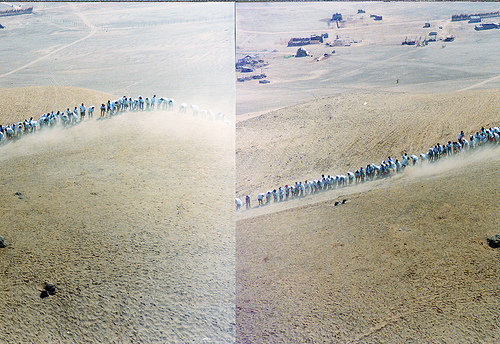Experimental Geography
dal 20/2/2010 al 29/5/2010
Segnalato da
Francis Alys
AREA Chicago
kanarinka
Catherine D!Ignazio
e-Xplo
Ilana Halperin
Julia Meltzer
David Thorne
Lize Mogel
Multiplicity
Trevor Paglen
Raqs Media Collective
Ellen Rothenberg
Spurse
Deborah Stratman
Daniel Tucker
Alex Villar
Yin Xiuzhen
Nato Thompson
20/2/2010
Experimental Geography
The Colby College Museum of Art, Waterville
In the hands of contemporary artists, the study of humanity's engagement with the earth's surface becomes a riddle best solved in experimental fashion. The exhibition presents a panoptic view of this new practice, through a wide range of mediums including sound and video installations, photography, sculpture, and experimental cartography. The approaches used by the artists featured range from the poetic to the empirical. The show is a traveling exhibition organized by iCI (Independent Curators International), New York.

Curated by Nato Thompson
Organized and circulated by iCI (Independent Curators International), New York
Artists:
Francis Alÿs
AREA Chicago
The Center for Land Use Interpretation (CLUI)
The Center for Urban Pedagogy (CUP)
kanarinka (Catherine D!Ignazio)
e-Xplo
Ilana Halperin
Julia Meltzer and David Thorne
Lize Mogel
Multiplicity
Trevor Paglen
Raqs Media Collective
Ellen Rothenberg
Spurse
Deborah Stratman
Daniel Tucker, project organizer
Alex Villar
Yin Xiuzhen
"Another step in the ongoing quest for social energies not yet recognized as art, Experimental
Geography brings together a significant group of artists and collectives looking seriously at land use-
-urban and rural, local and global. Leaving behind the earthworks of the past, and reviving the
line-blurring process that defined art and lived experience in 1960s conceptualism, much of this work
is not about geography but exist within geography, exploring the politics and infrastructures that can
either change or stall the world."
-Lucy Lippard, author of The Lure of the Local
Geography benefits from the study of
specific histories, sites, and
memories. Every estuary, landfill, and
cul-de-sac has a story to tell. The
task of the geographer is to alert us
to what is directly in front of us, while
the task of the experimental
geographer—an amalgam of
scientist, artist, and explorer—is to do
so in a manner that deploys
aesthetics, ambiguity, poetry, and a
dash of empiricism. This exhibition
explores the distinctions between
geographical study and artistic
experience of the earth, as well as
the juncture where the two realms collide
(and possibly make a new field altogether).
The manifestations of “experimental
geography” (a term coined by
geographer Trevor Paglen in 2002)
run the gamut of contemporary art
practice today: sewn cloth cities that
spill out of suitcases, bus tours
through water treatment centers,
performers climbing up the sides of
buildings, and sound art of the
breaths exhaled in running the
evacuation route of Boston. In the
hands of contemporary artists, the
study of humanity’s engagement with the earth’s topography becomes a riddle best solved in experimental
fashion. The exhibition presents a
panoptic view of this new practice,
through a wide range of mediums
including interactive computer units,
sound and video installations, photography,
sculpture, and experimental cartography.
The approaches used by the artists featured in
Experimental Geography range from a poetic
conflation of humanity and the earth to more
empirical studies of our planet. In 2002,
Francis Alÿs, in collaboration with Rafael
Ortega, Cuauhtémoc Medina, and 500
volunteers, created a human comb to move a
sand dune outside Lima, Peru. Although the
actual displacement was infinitesimal, its
metaphorical resonance was colossal.
Creating projects that are more empirically
minded, the Center for Land Use Interpretation (CLUI), a research organization, explores the
nature and extent of human interaction with the earth's surface, embracing a multidisciplinary
approach to fulfilling its mission. Using skill sets culled from the toolbox of geography, CLUI forces
a reading of the American landscape (which includes man-made islands, submerged cities, traffic in
Los Angeles, and the broadcast antennas in
the San Gabriel Mountains) that refamiliarizes
the viewer with the overlooked details of their
everyday experience.
Experimental Geography is curated by Nato Thompson, curator at Creative Time in New York. It is accompanied by an illustrated catalogue, co-published by ICI and Melville House, that includes essays by Thompson, Jeffrey Kastner, and Trevor Paglen.
About the guest curator, Nato Thompson:
Nato Thompson is a curator at Creative Time, New
York, as well as a writer and activist. Formerly at
MASS MoCA, Thompson has curated numerous
exhibitions including Ahistoric Occasion: Artists
Making History, Becoming Animal, and The
Interventionists: Art in the Social Sphere.
Thompson has also written for publications
including Cabinet Magazine, Art Journal, tema
celeste, and the Journal of Aesthetics and Protest.
Image: Francis Alÿs, The Making of Lima, 2002. Single-channel video projection with color and sound, 15 min., 37 sec. Courtesy of David Zwirner Gallery, New York
Media Contact Information: Ruth Jacobs
Office of Communications Tel 207-859-4353 pr@colby.edu
The Colby College Museum of Art
5600 Mayflower Hill Drive Waterville, ME 04901
Hours
Tuesday–Saturday 10 am – 4:30 pm
Sunday 12 – 4:30 pm
Closed Monday
Free and open to the public



